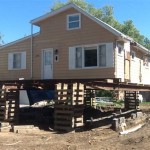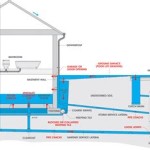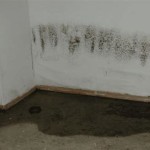How To Fix Water In Basement After Rain
Water in a basement after rain is a common problem for homeowners, and addressing it promptly is crucial to prevent structural damage, mold growth, and health hazards. Identifying the source of the water and implementing appropriate solutions are essential steps in mitigating future occurrences. This article provides a detailed guide on how to identify the causes of water intrusion, implement temporary fixes, and establish long-term solutions to keep basements dry.
The aftermath of a heavy rainfall can reveal vulnerabilities in a home's foundation and drainage system. Basement flooding can range from minor dampness to significant pooling of water, each level demanding a specific response. Ignoring the issue can lead to costly repairs and potential health problems. Therefore, a proactive approach involving assessment, immediate action, and preventive measures is paramount.
Identifying the Source of Water Intrusion
Pinpointing the source of basement water is the first and most critical step in addressing the problem. Several potential entry points exist, each requiring a specific investigation and remediation strategy. A systematic approach to identifying the source will lead to a more effective and targeted solution.
1. Check the Gutters and Downspouts: Gutters that are clogged with leaves, debris, or ice prevent rainwater from being properly diverted away from the foundation. This overflow can saturate the soil surrounding the basement walls, increasing the risk of water seepage. Inspect the gutters for any blockages and ensure that the downspouts extend at least 4-6 feet away from the foundation. The runoff should be directed to an area that slopes away from the house.
2. Examine the Grading Around the Foundation: The ground surrounding the foundation should slope away from the house. This positive slope directs surface water away from the building. If the ground slopes towards the foundation, or is even level, water will naturally collect and potentially seep through cracks or other vulnerabilities. Re-grading the soil can be a simple, yet effective, solution.
3. Inspect the Foundation Walls for Cracks: Even hairline cracks in the foundation walls or floors can allow water to penetrate the basement. These cracks can be caused by soil settlement, hydrostatic pressure, or temperature changes. Carefully examine the interior and exterior of the foundation walls for any signs of cracks. Note the size, location, and pattern of the cracks, as this information will be valuable for selecting the appropriate repair method. Larger cracks may indicate more significant structural issues that require professional evaluation.
4. Assess Window Wells: Window wells are designed to provide light and ventilation to basement windows, but they can also become a source of water intrusion if they are not properly drained. Make sure that window wells have adequate drainage systems, such as gravel or a drainage pipe connected to the perimeter drain. Check for debris accumulation, which can clog the drainage and cause water to pool in the well.
5. Evaluate the Perimeter Drain (French Drain): A perimeter drain, also known as a French drain, is a system of perforated pipes installed around the foundation to collect and divert groundwater away from the basement. If this system is clogged or damaged, it can become ineffective, leading to water buildup around the foundation. While typically not readily visible, signs of a failing perimeter drain include consistent dampness along the basement walls and persistent water intrusion even during light rainfall.
6. Check Indoor Plumbing: Although less frequent after heavy rain, it is important to rule out internal plumbing issues. Check for leaky pipes, malfunctioning appliances (like washing machines or water heaters), and condensation. Also, inspect the floor around toilets and sinks for signs of leaks.
Implementing Temporary Fixes
While identifying the source and planning long-term solutions, implementing temporary fixes can help minimize further water damage. These measures can buy time and prevent the situation from worsening before permanent repairs can be made.
1. Remove Standing Water: The immediate priority is to remove any standing water in the basement. Use a wet/dry vacuum, sump pump, or buckets to remove the water. Ensure electrical safety protocols are followed when using electrical appliances in a wet environment. Wear appropriate protective gear, such as rubber gloves and boots, to avoid contact with contaminated water.
2. Dry Out Affected Areas: After removing standing water, it is crucial to dry out the affected areas to prevent mold growth. Use fans and dehumidifiers to circulate air and reduce humidity. Open windows, if weather permits, to promote ventilation. Remove any wet materials, such as carpets, rugs, or furniture, to a dry location to prevent further damage.
3. Seal Cracks Temporarily: For small cracks in the foundation walls, use hydraulic cement or waterproof sealant to create a temporary barrier. These products are designed to expand as they dry, effectively plugging the crack and preventing further water intrusion. Follow the manufacturer's instructions carefully when applying these products.
4. Divert Water Away from Foundation: Even temporarily extending downspouts or using tarps to redirect water away from the foundation can help reduce the amount of water saturating the ground around the basement.
5. Protect Valuables: Raise any valuable items off the floor to prevent water damage. Store items in waterproof containers or wrap them in plastic sheeting. Move furniture to a drier location or cover it with waterproof covers.
Establishing Long-Term Solutions
Addressing the root causes of basement water intrusion is essential for preventing future problems. Long-term solutions focus on improving drainage, sealing the foundation, and improving indoor humidity control. These measures provide lasting protection against water damage and mold growth.
1. Improve Exterior Drainage: This is often the most critical step. This includes ensuring properly functioning gutters and downspouts that discharge water far from the foundation. Re-grading the soil around the foundation to create a positive slope away from the house is also vital. Installing or improving a French drain system can effectively manage groundwater levels around the foundation.
2. Seal Foundation Cracks Permanently: Small cracks can be sealed with epoxy injections, which provide a strong, waterproof barrier. Larger cracks may require more extensive repairs, such as patching with hydraulic cement or applying a waterproof membrane. If the cracks are caused by structural problems, consult with a structural engineer to determine the best course of action.
3. Waterproof the Foundation: Applying a waterproof coating to the exterior of the foundation walls can provide a robust barrier against water penetration. This is especially effective when combined with a perimeter drain system. The process typically involves excavating around the foundation, applying the waterproofing membrane, and then backfilling with appropriate drainage materials.
4. Install a Sump Pump: A sump pump is an electric pump that removes water that accumulates in a sump pit, typically located in the basement. It is particularly useful in areas with high water tables or frequent flooding. The sump pump should be equipped with a battery backup in case of power outages. Regular maintenance is important to ensure that the pump functions properly.
5. Improve Basement Ventilation and Humidity Control: Adequate ventilation can help reduce humidity levels in the basement and prevent condensation. Run a dehumidifier to maintain a comfortable humidity level. Consider installing a vapor barrier on the walls and floor to prevent moisture from seeping into the basement.
6. Consider Professional Consultation: If the water intrusion is severe or the source is difficult to identify, it is advisable to consult with a professional waterproofing contractor. They can conduct a thorough assessment of the property and recommend the most appropriate solutions. A structural engineer can also provide valuable insights if there are concerns about the structural integrity of the foundation.
7. Extend Downspouts: Ensure downspouts are extended far enough from the foundation, typically 4-6 feet, to direct water away from the house. Use downspout extensions or splash blocks to facilitate this. This prevents water from pooling near the foundation and seeping into the basement.
8. Clean Gutters Regularly: Routine gutter cleaning is crucial to prevent blockages that can cause water to overflow and saturate the soil around the foundation. Clean gutters at least twice a year, in the spring and fall, to remove leaves, debris, and other obstructions.
9. Monitor Water Table: If in an area with a high water table, consider monitoring its levels, especially during periods of heavy rain. This can provide insight into the effectiveness of the perimeter drain system and the potential for future water intrusion.
Preventing water in the basement after rain involves a comprehensive approach that combines source identification, temporary mitigation, and long-term solutions. Regular maintenance, proactive measures, and, when necessary, professional intervention are crucial for maintaining a dry and healthy basement environment.

How To Fix Water Leaking Into Basement After Heavy Rain Gj Macrae

Why Your Basement Leaks In Heavy Rain

Why Your Basement Leaks In Heavy Rain

Water Leaking Into Basement After Heavy Rain How To Stop It

Help My Basement Leaks When It Rains News And Events For Systems Inc

7 Ways To Stop Rain Leaking Into Your Basement Baker S Waterproofing

The Best Methods For Basement Leak Repair Acculevel

Get To Know How A Leaky Basement Can Ruin Your Home

Why Is Water Leaking Into My Basement After Heavy Rain

Finding And Fixing Basement Leaks How To Waterproof Your
Related Posts







